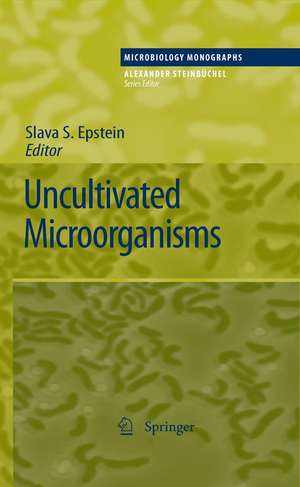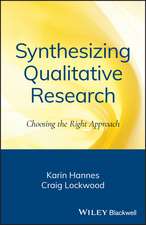Uncultivated Microorganisms: Microbiology Monographs, cartea 10
Editat de Slava S. Epsteinen Limba Engleză Paperback – 29 noi 2011
| Toate formatele și edițiile | Preț | Express |
|---|---|---|
| Paperback (1) | 1594.75 lei 6-8 săpt. | |
| Springer Berlin, Heidelberg – 29 noi 2011 | 1594.75 lei 6-8 săpt. | |
| Hardback (1) | 1602.26 lei 6-8 săpt. | |
| Springer Berlin, Heidelberg – 23 iul 2009 | 1602.26 lei 6-8 săpt. |
Din seria Microbiology Monographs
- 18%
 Preț: 953.82 lei
Preț: 953.82 lei - 18%
 Preț: 956.33 lei
Preț: 956.33 lei - 18%
 Preț: 951.29 lei
Preț: 951.29 lei - 18%
 Preț: 952.09 lei
Preț: 952.09 lei - 18%
 Preț: 1224.36 lei
Preț: 1224.36 lei - 18%
 Preț: 939.00 lei
Preț: 939.00 lei - 18%
 Preț: 1547.49 lei
Preț: 1547.49 lei - 18%
 Preț: 946.41 lei
Preț: 946.41 lei - 18%
 Preț: 1224.68 lei
Preț: 1224.68 lei - 18%
 Preț: 947.35 lei
Preț: 947.35 lei - 15%
 Preț: 645.47 lei
Preț: 645.47 lei - 18%
 Preț: 1227.21 lei
Preț: 1227.21 lei - 18%
 Preț: 941.05 lei
Preț: 941.05 lei - 18%
 Preț: 946.55 lei
Preț: 946.55 lei - 18%
 Preț: 945.62 lei
Preț: 945.62 lei - 18%
 Preț: 1112.15 lei
Preț: 1112.15 lei - 18%
 Preț: 955.70 lei
Preț: 955.70 lei - 18%
 Preț: 944.19 lei
Preț: 944.19 lei - 18%
 Preț: 954.62 lei
Preț: 954.62 lei - 18%
 Preț: 950.66 lei
Preț: 950.66 lei - 15%
 Preț: 645.47 lei
Preț: 645.47 lei - 15%
 Preț: 643.34 lei
Preț: 643.34 lei - 18%
 Preț: 1225.94 lei
Preț: 1225.94 lei - 18%
 Preț: 947.04 lei
Preț: 947.04 lei - 18%
 Preț: 1113.58 lei
Preț: 1113.58 lei
Preț: 1594.75 lei
Preț vechi: 1678.69 lei
-5% Nou
Puncte Express: 2392
Preț estimativ în valută:
305.15€ • 318.60$ • 252.55£
305.15€ • 318.60$ • 252.55£
Carte tipărită la comandă
Livrare economică 04-18 aprilie
Preluare comenzi: 021 569.72.76
Specificații
ISBN-13: 9783642242588
ISBN-10: 3642242588
Pagini: 220
Ilustrații: X, 208 p. 33 illus., 10 illus. in color.
Dimensiuni: 155 x 235 x 12 mm
Greutate: 0.31 kg
Ediția:2009
Editura: Springer Berlin, Heidelberg
Colecția Springer
Seria Microbiology Monographs
Locul publicării:Berlin, Heidelberg, Germany
ISBN-10: 3642242588
Pagini: 220
Ilustrații: X, 208 p. 33 illus., 10 illus. in color.
Dimensiuni: 155 x 235 x 12 mm
Greutate: 0.31 kg
Ediția:2009
Editura: Springer Berlin, Heidelberg
Colecția Springer
Seria Microbiology Monographs
Locul publicării:Berlin, Heidelberg, Germany
Public țintă
ResearchCuprins
Viable but Not Cultivable Bacteria.- General Model of Microbial Uncultivability.- Statistical Estimation of Uncultivated Microbial Diversity.- Detection and Characterization of Uncultivated Microorganisms Using Microarrays.- Persisters, Biofilms, and the Problem of Cultivability.- Metagenomics and Antibiotic Discovery from Uncultivated Bacteria.- Taking the Concept to the Limit: Uncultivable Bacteria and Astrobiology.- Single Cell Whole Genome Amplification of Uncultivated Organisms.- Physiological and Ecological Adaptations of Slow-Growing, Heterotrophic Microbes and Consequences for Cultivation.- Characterizing Microbial Population Structures through Massively Parallel Sequencing.- The Seabed as Natural Laboratory: Lessons From Uncultivated Methanotrophs.
Textul de pe ultima copertă
The number of existing microbial species may be in the millions, but only a few thousand have been isolated in pure culture and described. The principal reason for this tremendous disparity is that, mysteriously, over 99% of all environmental microorganisms refuse to grow in the laboratory. The phenomenon of microbial uncultivability has been recognized as one of the main challenges for basic and applied microbiology, and finding a way to access this uncultivated microbial majority may change many aspects of biology and biotechnology as we know them today.
This volume describes the discovery of the phenomenon, the current hypotheses on its physiological and molecular nature, state-of-the-art approaches to "outsmarting" the uncultivated microorganisms, and the importance of the uncultivated microbial majority in medicine and biotechnology. It reveals the hidden universe of uncultivated microorganisms, their unparalleled diversity and enormous potential for application.
This volume describes the discovery of the phenomenon, the current hypotheses on its physiological and molecular nature, state-of-the-art approaches to "outsmarting" the uncultivated microorganisms, and the importance of the uncultivated microbial majority in medicine and biotechnology. It reveals the hidden universe of uncultivated microorganisms, their unparalleled diversity and enormous potential for application.
Caracteristici
Includes supplementary material: sn.pub/extras














